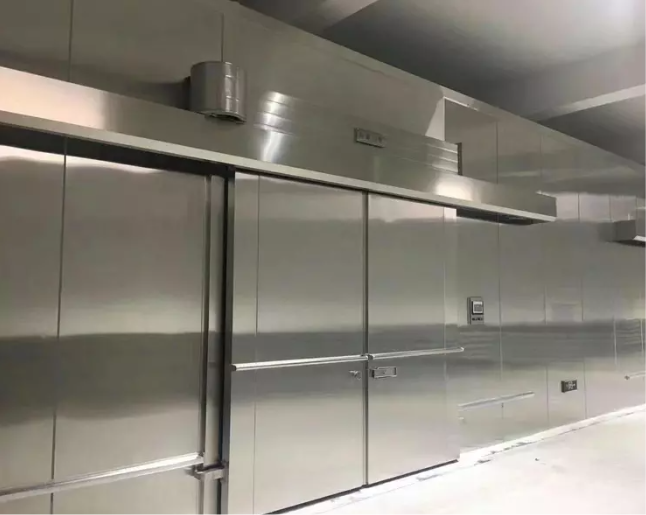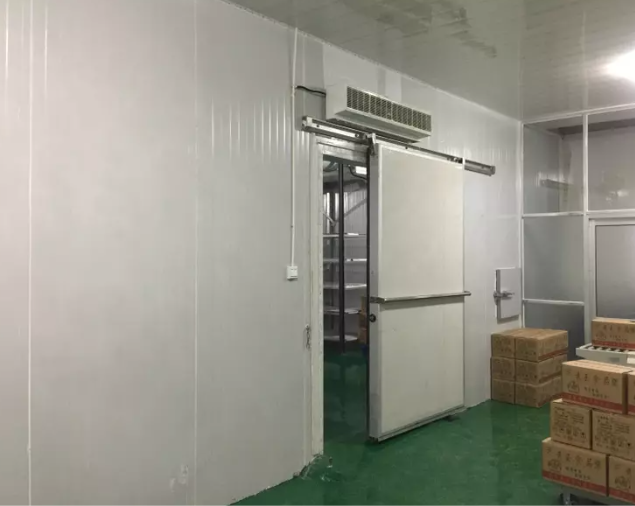Have you ever wondered how businesses store perishable goods safely? Cold rooms play a vital role in ensuring products last longer and stay fresh.In this post, we'll explore what cold rooms are, how they work, and their key benefits. You'll also learn about the different applications of cold rooms in various industries.
Understanding Cold Rooms
What is a Cold Room?
A cold room is an insulated space used to store products at specific temperatures, often lower than the surrounding environment. It ensures that perishable items remain fresh for longer periods. Cold rooms are especially popular in industries where temperature control is essential for preserving the quality of products.
In the food industry, for example, cold rooms maintain proper temperatures for items like meat, dairy, and produce. Pharmaceuticals and chemicals also rely on cold rooms to store sensitive materials, ensuring that temperature fluctuations do not degrade product quality.
These storage spaces go by several names, including walk-in refrigerators and cold storage rooms. Regardless of the name, all cold rooms function to provide an environment where temperatures remain consistently low, which is essential for storing goods that require special care.

Why are Cold Rooms Important?
Cold rooms play a crucial role in industries that deal with perishable goods. They're especially significant for food preservation, where they help maintain the freshness of products like fruits, vegetables, and meats. Without cold rooms, it would be nearly impossible to keep food safe and prevent spoilage over time.
Besides food, pharmaceutical and chemical industries rely on cold rooms to store vaccines, medications, and certain chemicals at the right temperatures. These controlled environments prevent deterioration or chemical reactions that could compromise the integrity of these products.
Cold rooms offer several benefits over traditional refrigeration. For one, they provide larger storage capacity, meaning businesses can store more items without needing multiple smaller refrigerators. Additionally, they are energy-efficient, which helps reduce costs. Cold rooms also maintain consistent temperatures, avoiding the temperature fluctuations common in smaller fridges that can cause spoilage or product damage.

How Does a Cold Room Work?
The Basic Working Principle
Cold rooms rely on the refrigeration cycle to maintain low temperatures. This process includes compression, condensation, expansion, and evaporation.
Refrigeration Cycle Breakdown:
● Compression: The compressor compresses the refrigerant gas, raising its pressure and temperature.
● Condensation: The high-pressure gas then enters the condenser, where it cools down and turns into a liquid.
● Expansion: The liquid refrigerant moves through an expansion valve, where it rapidly expands and cools.
● Evaporation: Finally, the cool refrigerant absorbs heat from the air inside the cold room in the evaporator coils, which reduces the room's temperature.
This cycle repeats continuously, ensuring the cold room remains at the desired temperature.
Components Involved:
● Compressor: Compresses refrigerant to increase pressure.
● Condenser: Cools down the refrigerant and changes it into a liquid.
● Expansion Valve: Reduces pressure and temperature of refrigerant.
● Evaporator: Absorbs heat from the air to cool the room.
Temperature Control in Cold Rooms
Cold rooms maintain specific temperatures based on what is being stored. For example, food items like meat and dairy require temperatures between 0°C and 4°C, while pharmaceuticals may need colder environments.
Typical Temperature Ranges:
● Walk-in Refrigerators: 0°C to 4°C (for food like meat, dairy, and vegetables)
● Walk-in Freezers: -18°C or colder (for frozen foods or ice cream)
● Pharmaceutical Cold Rooms: -20°C to -80°C (for vaccines and medical supplies)
Differences Between Walk-in Refrigerators and Freezers:
Feature | Walk-in Refrigerator | Walk-in Freezer |
Temperature Range | 0°C to 4°C | -18°C and colder |
Primary Use | Food, drinks, flowers | Frozen foods, ice cream |
Energy Consumption | Lower than freezers | Higher than refrigerators |
Storage Capacity | Larger volumes | Typically smaller than refrigerators |
Maintaining proper temperature regulation is critical for preserving the quality and safety of stored goods. Temperature fluctuations can lead to spoilage or even pose health risks, making cold rooms essential for industries dealing with sensitive materials.
The refrigeration system in a cold room ensures a consistent temperature, reducing the risk of these fluctuations and keeping everything stored safely.
Key Features and Benefits of Cold Rooms
Energy Efficiency
Cold rooms are designed to be energy-efficient, helping businesses save on operating costs. They use advanced technology to maintain a constant temperature, which reduces the need for frequent adjustments.
How Cold Rooms Help Reduce Energy Costs:
● Consistent Temperature: Cold rooms maintain a steady temperature, preventing unnecessary energy use that comes with frequent temperature changes.
● Insulation: High-quality insulation helps to keep the cold air in and the heat out, further reducing energy consumption.
Energy-Saving Features:
● Automatic Defrost: Cold rooms often include automatic defrost systems that help prevent ice buildup, reducing energy waste and improving efficiency.
● Temperature Control Systems: Modern cold rooms are equipped with advanced temperature control systems that ensure optimal conditions for stored goods without wasting energy.
Storage Capacity and Organization
Cold rooms offer large storage capacities, making them ideal for businesses that handle high inventory levels. Their spacious design allows for better organization and more efficient storage.
Large Storage Capacity:
● More Storage: Cold rooms can accommodate large quantities of goods, reducing the need for multiple smaller refrigerators and freezers.
● Cost-Effective: Businesses can store more products in one place, saving on costs associated with purchasing and maintaining multiple units.
Shelving Systems and Organization:
● Customizable Racking: Cold rooms often have adjustable shelving systems, allowing businesses to organize their goods based on their specific needs.
● Improved Accessibility: Proper organization within the cold room ensures that products are easy to access, making it easier to restock and retrieve items.
Security and Accessibility
Cold rooms are equipped with security features to protect valuable goods and ensure easy access for stock management.
Security Features:
● Anti-Theft Measures: Many cold rooms come with built-in locks and secure entry points, protecting goods from theft.
● Safety Alarms: Some models include alarms that activate if the temperature goes beyond the set range or if the door is left open.
Easy Accessibility:
● User-Friendly Design: Cold rooms are designed for easy access, whether it's restocking supplies or retrieving ingredients.
● Convenient Door Systems: Doors can be designed to open smoothly, ensuring that staff can move items in and out of the cold room with ease.
Temperature Consistency
Maintaining consistent temperature is one of the most important features of a cold room. Fluctuations in temperature can cause spoilage and damage to stored goods.
Maintaining Consistent Temperature:
● Advanced Thermostat Control: Cold rooms have thermostats and sensors to monitor temperature levels, ensuring consistency throughout the room.
● Uniform Airflow: Proper airflow and circulation are maintained to keep temperatures stable in every corner of the room.
Avoiding Temperature Fluctuations:
● Reduced Risk of Spoilage: Consistent temperature reduces the chances of spoilage, especially for perishable goods like food and medicine.
● Protecting Product Quality: Temperature stability helps preserve the integrity and freshness of items, preventing quality degradation.
Cold Room Considerations for Businesses
Choosing the Right Cold Room for Your Business
When selecting a cold room, several factors need to be considered to ensure it meets your business needs.
Key Factors to Consider:
● Size: Cold rooms come in various sizes. Choosing the right size depends on the volume of products you plan to store. Ensure the space is large enough to accommodate your inventory but not so large that it wastes energy.
● Temperature Range: Different products require different temperatures. Make sure the cold room can be set to the right temperature for what you need, whether it's for refrigeration or freezing.
● Location: Where you place the cold room is crucial. It should be easily accessible and located in an area where temperature fluctuations are minimal.
Assessing Ambient Temperature and Ventilation Needs:
● Ambient Temperature: The temperature of the surrounding environment affects how well the cold room operates. It's important to assess the highest ambient temperature in the area where the cold room will be installed.
● Ventilation: Cold rooms need proper ventilation to function efficiently. Ensure there's enough space for air circulation and that the room isn't in a confined area where airflow may be restricted.
Cold Room Installation
The installation of a cold room should be carefully planned and executed to ensure optimal performance.
Step-by-Step Installation Process:
1. Site Survey: A professional will assess the location and gather measurements to determine the best position for the cold room.
2. Foundation Preparation: Ensure the floor is level and stable, and that it can support the weight of the cold room.
3. Assembly: The cold room panels and components are assembled. The refrigeration system is connected, and temperature controls are set.
4. Testing: After installation, the cold room is tested to ensure it maintains the correct temperature and functions properly.
Professional Installation and Ongoing Maintenance:
● Professional Installation: Always hire experts to install your cold room. Proper installation ensures the system works efficiently and safely.
● Ongoing Maintenance: Regular maintenance is essential to keep the cold room functioning at its best. This includes cleaning, checking for refrigerant leaks, and servicing the cooling system.
Cost Considerations and Return on Investment
While cold rooms require an upfront investment, they provide long-term savings and benefits.
Initial Cost vs. Long-Term Savings:
● Initial Cost: The price of a cold room includes the unit itself, installation, and any required setup. The cost will depend on size, features, and installation complexity.
● Long-Term Savings: Cold rooms are energy-efficient and help reduce costs over time by reducing the need for multiple smaller units and cutting down energy consumption.
Economic Benefits of Using Cold Rooms:
● Efficiency: In businesses like commercial kitchens or warehouses, cold rooms allow for better organization and reduce the need for constant restocking.
● Space Saving: Cold rooms provide a centralized storage space, freeing up valuable space in other areas of your business.
● Preserving Product Quality: By maintaining consistent temperatures, cold rooms help preserve product quality, reducing waste and improving profitability.
Applications of Cold Rooms Across Different Industries
Food Storage and Preservation
Cold rooms are vital for preserving the quality and safety of perishable food items. By maintaining a low, consistent temperature, they extend the shelf life of goods that would otherwise spoil quickly.
How Cold Rooms Extend the Shelf Life of Perishable Goods:
● Slows Down Decomposition: Lower temperatures slow down the natural processes of decay, allowing food to last longer.
● Prevents Bacterial Growth: Cold rooms help prevent harmful bacteria from growing on food, reducing spoilage.
Common Products Stored in Cold Rooms:
● Meat: Beef, poultry, and other meats are stored at precise temperatures to maintain freshness.
● Seafood: Fish and shellfish require low temperatures to keep them fresh and safe to eat.
● Dairy: Milk, cheese, and butter need constant refrigeration to maintain their quality.
● Fruits and Vegetables: Cold storage keeps produce fresh and reduces spoilage.
Pharmaceutical and Medical Applications
Cold rooms also play a key role in industries like pharmaceuticals and healthcare, where maintaining specific temperatures is critical.
Cold Rooms for Storing Vaccines, Medicines, and Biological Samples:
● Vaccines: Many vaccines must be stored at very precise temperatures to remain effective.
● Medicines: Some medications, especially biologics, require cold storage to prevent them from losing potency.
● Biological Samples: Research labs and hospitals use cold rooms to store biological samples like blood or tissues that need refrigeration.
Importance of Maintaining Precise Temperature Control:
● Temperature Sensitivity: Small temperature variations can affect the efficacy and safety of medications.
● Regulatory Requirements: Many pharmaceutical products are subject to strict regulations requiring accurate temperature control and monitoring.
Floral and Agricultural Uses
Cold rooms are also used to preserve the freshness of flowers, plants, and agricultural products.
Storing Flowers, Plants, and Crops to Prolong Freshness:
● Flowers: Cold storage slows down the aging process of cut flowers, helping them stay fresh longer for sale and use.
● Plants and Crops: Certain plants and crops are kept in cold rooms to prevent spoilage during transportation and before sale.
Cold Rooms for Preserving Agricultural Products:
● Agricultural Produce: Fruits and vegetables are stored at controlled temperatures to maintain their quality and extend shelf life.
● Grains and Seeds: Cold rooms can also be used to store grains and seeds, preventing pests and maintaining their viability.
Conclusion
Cold rooms are invaluable for businesses that require consistent temperature control. They extend product shelf life, improve efficiency, and ensure safety. Investing in a cold room helps preserve goods, reduce waste, and save on energy costs.
When choosing a cold room, consider your business's specific needs, such as size, temperature range, and location. Selecting the right cold room ensures your products are stored properly and your operations run smoothly.
FQA
Q: What Temperature Should a Cold Room Be Set To?
A: Cold rooms typically operate between 0°C and 10°C for food storage. For pharmaceuticals, temperatures range from -20°C to -80°C. Chemicals may require specific temperatures based on their sensitivity.
Q: Can a Cold Room Be Moved After Installation?
A: Cold rooms are generally not designed to be moved easily. While some models are portable, moving them after installation requires professional assistance to avoid damage.
Q: How Are Cold Rooms Powered?
A: Most cold rooms are powered through standard electrical plugs, though larger models may require a hardwired connection for more power.
Q: What Are the Safety Considerations When Using Cold Rooms?
A: Key concerns include mold exposure, which can affect health, and oxygen deficiency in sealed environments. Always follow emergency procedures like ensuring ventilation and proper use of protective gear.
Q: Are Cold Rooms Only Used for Food?
A: No, cold rooms are also essential in pharmaceuticals, chemicals, agriculture, and floral industries, providing temperature-controlled storage for sensitive products.



